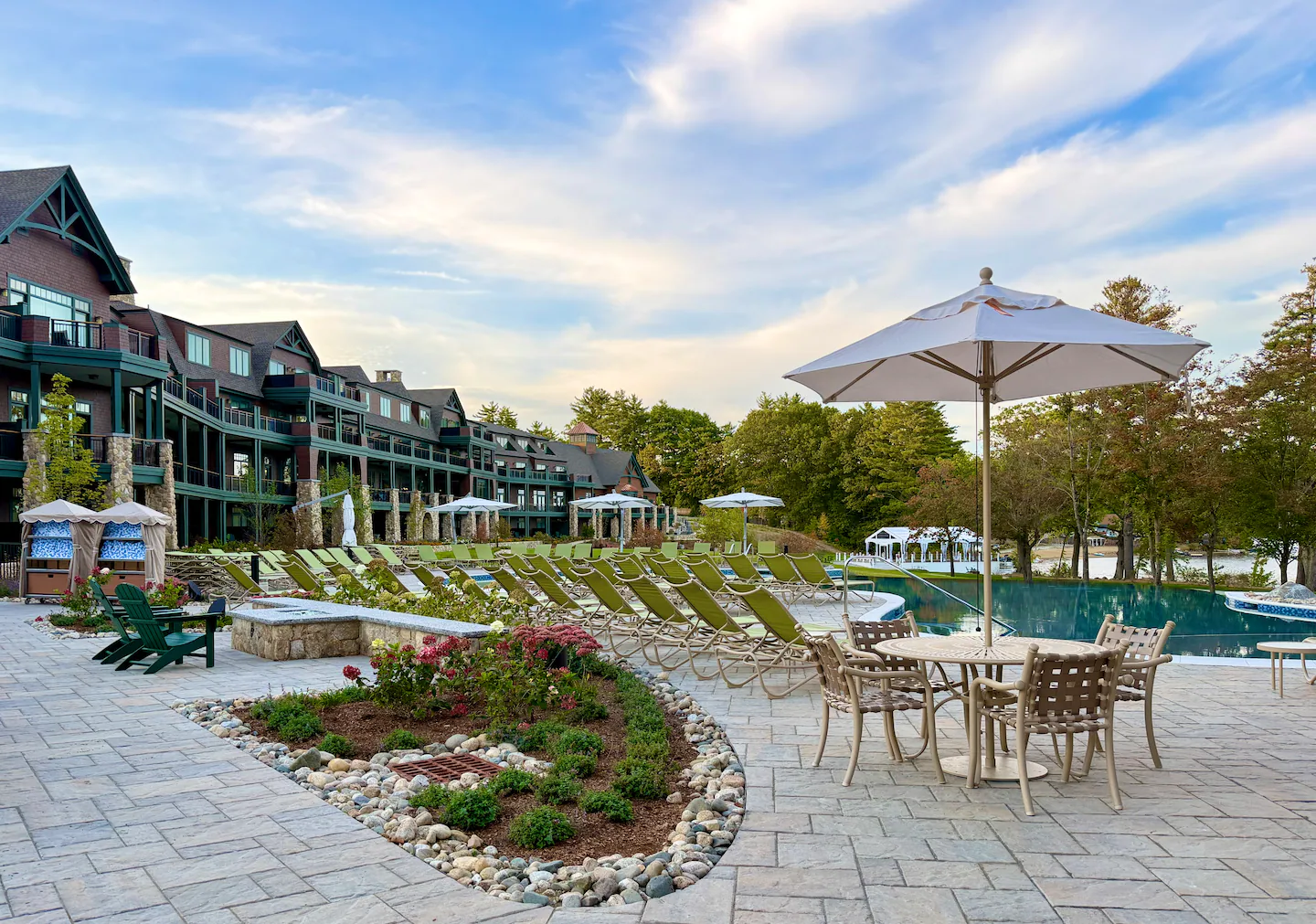
I’m relieved to say that, despite the apparent obstacles, the Lake Estate on Winnisquam has been flawlessly executed. Nearly every detail is thoughtfully and purposefully accounted for, and I say this as someone who has stayed in hundreds of hotels ranging from $200 to $2,000 a night. Those cost overruns happened for a reason. The final price tag of the Lake Estate was “just north of $90 million,” although someone close to the project told me on background that the final number was closer to $110 million.
But forget about building costs for a moment. My main concern as I drove the circuitous road to the resort was how it would fit into the landscape. The Lakes Region of New Hampshire is rustic — that’s not an insult. It’s not Newport, Bar Harbor, or Cape Cod. The words luxury and rustic don’t sound as if they belong in the same sentence, and often they don’t. Striking the right balance here is a bit of a nail-biter. You can’t plunk the Wauwinet or the White Barn Inn in front of a New Hampshire lake and expect the chemistry to work.
The exterior view is the first indication that the Lake Estate was created with its surroundings top of mind. It’s modeled after the grand lake cottages of yore, albeit on steroids. Stone and cedar shingles are the primary exterior materials, and the earth tones help the resort blend into the landscape. The description I kept coming back to in my mind is that it feels as if you’re staying at a wealthy uncle’s sprawling lakefront cabin or you’re visiting a monied friend’s guest house, particularly with building accents painted hunter green. The lack of pretense fits the New England model of invisible wealth.
Designed by Samyn-D’Elia Architects, the Lake Estate borrows heavily from classic New England architectural styles. Aside from its grand size, it fits nicely into the landscape and gives the impression that it’s a structure that could have sat alongside the lake for the past 100 years. No small feat for a resort that sports four pickleball courts and a tennis court.
The Lake Estate is on 36 acres with two private, sandy beaches where guests have access to paddle boards, canoes, and kayaks. There are walking and running trails, plus an apple orchard. There’s an outdoor pool with a poolside restaurant and two hot tubs. Next year, there will be a beachside bourbon bar.
Inside, there’s a 5,000-square-foot spa and salon, a fitness center, a wine cellar, a private screening room, a fine dining restaurant, a bar, a library with a grand piano, and an expansive ballroom for weddings, complete with an in-house florist. Weddings are a key part of the resort’s business model, and since opening in August, they’ve already hosted five, with nine more happening in 2025. They’ve already booked 25 weddings for 2026.
I checked in on a warm, sleepy Monday afternoon and paid $489 for a deluxe, lakeview room. With taxes and resort fees, the total was $565 for the night. Rates range seasonally, starting at $399 up to $1,900 for a two-bedroom suite (in high season) per room, per night. I slipped in undetected as a reporter and headed to my room, which was an ample 420 square feet.
The first thing I noticed was the textures. A solid wood floor gave way to sturdy plaid, preppy carpet. The substantial furniture was made for the hotel, and the woodwork in the room lent to the narrative that this was a building that had been here for decades. No exaggeration — there are miles of crown molding throughout the hotel.
The bed, truly the most important aspect of the room, was comfortable. I was a bit taken aback by the quilt on the bed (really, a quilt?), but it plays into the idea that this is a place that’s been here for years and helps strip away any pretense. My only complaint was that there were folding shutters that opened from a window in the bathroom into the bedroom area. I suspect this is so you could get a glimpse of the lake from the tub, but I’m a firm believer that there should always be a distinct and solid separation between the bathroom and the sleeping area of any hotel room. It’s the hospitality version of a separation between church and state.
Walking around the hotel, it was clear that finishes everywhere are high-end, but it’s not an intimidating space. I never felt as if I was underdressed, and I wasn’t afraid to plop down on any of the sofas or chairs in the abundant nooks leading to the bar and dining room. There are old paintings hanging alongside new, tchotchkes that look as if they might be family heirlooms, and a grandfather clock.
What’s most impressive is that the Lake Estate is an independent hotel that had no road map or aesthetic protocols. Patti and Ed Rocco, who serve as estate manager (Patti) and general manager (Ed), have years of experience in hospitality and created a brand with its own identity out of thin air. With the help of Fuel Hospitality, a strategic branding company based in Milwaukee that works with independent hotels and restaurants, the Roccos took their years of experience, combined it with what they had learned staying in high-end properties, and came up with an identity for the resort. It’s also safe to assume that Dan Dagesse, the car dealer magnate who is bankrolling most of the project, along with his wife, Elaine, might have contributed a couple of ideas.
If they succeed in their mission, the Lake Estate will be the first property in New Hampshire to be included in the prestigious guide.
But it’s the Roccos who have been carefully studying the Forbes Travel Guide protocols, hoping to land the Lake Estate on the list with four or five stars. If they’re able to do so, it will be the first property in New Hampshire to make the prestigious guide. Earning stars from Forbes isn’t just about having 25 fireplaces, four pickleball courts, and a ballroom. Service is key. The staff here is outgoing and friendly, but might need a bit more seasoning until they’ve hit their stride.
Perhaps the most formal guest space is the stunning dining room. Although it was alluring, I was traveling solo and was looking for a more informal space to dine. I sat at the bar, where I could order from the main dining room menu, and enjoyed the company of the bar staff. Chris Viaud (formerly of Deuxave) was tapped as chef for the hotel’s signature restaurant. I ordered the tagliatelle bolognese from the dining room menu, and at $42, it was underwhelming. But my purpose here was to review the property, not the restaurant or spa (those reviews will be coming in the future).
There are many grand features at the Lake Estate on Winnisquam to be impressed with, but what struck me the most were the blink-and-you-miss-them details. Look carefully at the carpet in the corridor; the pattern looks like leaves that have fallen on the forest floor. The art around the hotel echoes the natural surroundings, and the sconces in the hallways mirror the branches outside. The blotter on the desk in my room was actual leather, as were the tray and trash cans.
The patterns, textures, and materials are as high-quality as the landscape outside. It’s tastefully and genuinely presented in a manner that fits its surroundings. I don’t need a crystal ball to see that the Lake Estate on Winnisquam will someday have its Forbes stars.



